
Part 1
Understanding matchups is one of the most critical skills that any player can develop if he or she wants to be better at Vs. System. Knowing how card values shift when played against different strategies will allow you to deploy and answer threats more efficiently than your opponent.
Before we get down to business, here’s a quick word on identifying matchups. In many of the articles I read and in many of the conversations I have with other players, a dangerous assumption is often employed. Too many people assume that they know what their opponent is playing straight away. In the one-game format, this can be a very costly assumption. If an opponent plays She-Thing on turn 2, is that person playing Common Enemy or Fantastic Fun? Or maybe even plain FF Curve? At some point or another, you have to put your opponent on something; however, I want to point out from the outset that this is rarely a fixed state of affairs. Be careful without being too conservative. Be prepared to change your mind sometimes.
As a recap, here’s the list I posted in my last article:
Alex Brown
Teen Titans August 2005
I will be referring to this list throughout the article. I’m far from convinced that it is definitive and I welcome any supported criticism. That said, I still need to anchor my views somewhere.
Versus Curve Sentinels
This matchup is probably the most misunderstood issue in Vs. System. Ryan Jones recently wrote an article at VsUniverse.com giving some of his opinions on the subject, and I would recommend it to anyone without an issue against purchasing a premium membership to that site. His general point, with which I agree, is that this matchup is unfavorable for the Titans player. I find particular resonance in his frustration with the popular belief that the Titans deck is just so complex that the pilot must have erred if he or she lost to the lumbering and simplistic Sentinel deck. The matchup is definitely difficult for both sides and involves many nuances, but at its core, it is generally in the Sentinels’ favor.
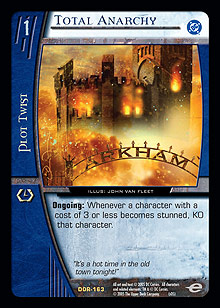 The Titans player is generally well equipped to face the archetypal Curve deck. Builds such as Big Brother typically find themselves shredded by Tim Drake & Co. However, Curve Sentinels is a little more than your average curve deck. Firstly, the Sentinels player is plausibly able to curve out from the first turn. Combined with the threat of Total Anarchy or Micro-Sentinels, the Titans player is given little time to set up the team-attack complex. Furthermore, Search and Destroy and Flame Trap create more uncertainty in the mind of the Titans player, who needs to have a face-up Tim Drake in play when he or she has to win. Thus, one of the most important things to realize, if you are familiar with legal jargon, is that the burden of proof is on the Titans player. The Titans will lose the long game, but when forced to act, they cannot be sure of what sort of defensive measures the Sentinels player has up his or her sleeve. This uncertainty gnaws at the Titans player and makes it very difficult to calculate the win properly.
The Titans player is generally well equipped to face the archetypal Curve deck. Builds such as Big Brother typically find themselves shredded by Tim Drake & Co. However, Curve Sentinels is a little more than your average curve deck. Firstly, the Sentinels player is plausibly able to curve out from the first turn. Combined with the threat of Total Anarchy or Micro-Sentinels, the Titans player is given little time to set up the team-attack complex. Furthermore, Search and Destroy and Flame Trap create more uncertainty in the mind of the Titans player, who needs to have a face-up Tim Drake in play when he or she has to win. Thus, one of the most important things to realize, if you are familiar with legal jargon, is that the burden of proof is on the Titans player. The Titans will lose the long game, but when forced to act, they cannot be sure of what sort of defensive measures the Sentinels player has up his or her sleeve. This uncertainty gnaws at the Titans player and makes it very difficult to calculate the win properly.
And that’s not all the Titans worries in this matchup. Nimrod is a massive threat. So good is Nimrod against this deck that he is often the optimal seventh turn and fifth turn play. Apart from playing around Betrayal, Nimrod counters the uniquely Titanesque strategy of focusing not on the quality or size of the characters, but on the quantity of the characters. Essentially, the repair counter on Nimrod negates a Teen Titans Go! This is bad news for the Titans player, who generally needs not only multiple copies of Teen Titans Go! now, but also has to hit and maintain a perfect curve from turns 2 through 5. While this is easier for the Titans deck than for others, it is generally costly on other resources and leaves little room for bad decisions.
With all of that out of the way, I would like to share my plan of attack against Curve Sentinels. I am going to split this into even and odd initiatives because I think a different plan applies to each. Generally, I want the odd initiative with this deck, but against Curve Sentinels, I want evens. This is relatively easy to get unless you’re playing against a disciple of the Jones school of Sentinels, which advocates evens so that you can Finishing Move/Bastion in the mirror. If so, bad times for you, but the odd initiative plan is below.
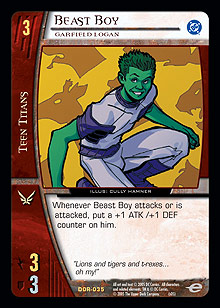 If you have evens, your optimal recruitment plan is Tim Drake, Beast Boy, and then Red Star. You really want a Tamaran here for two reasons. On turn 3, it ensures that the opponent’s Mark II gets stunned if it attacks Tim Drake, making Total Anarchy risky. Alternatively, it keeps Beast Boy out of stun range of the Mark II. On turn 4, the Tamaran will allow you to clear your opponent’s board with Teen Titans Go!, KO’ing the Mark II so that Roy will be active next turn.
If you have evens, your optimal recruitment plan is Tim Drake, Beast Boy, and then Red Star. You really want a Tamaran here for two reasons. On turn 3, it ensures that the opponent’s Mark II gets stunned if it attacks Tim Drake, making Total Anarchy risky. Alternatively, it keeps Beast Boy out of stun range of the Mark II. On turn 4, the Tamaran will allow you to clear your opponent’s board with Teen Titans Go!, KO’ing the Mark II so that Roy will be active next turn.
One of the benefits of having four copies of Optitron in your deck is that you can go off curve when necessary. The threat of Nimrod is so immense that you need to preserve numbers to keep your team-attacks effective for when you need to win. By deploying Roy Harper on turn 5, you are effectively holding the fort. Roy is rarely good in this matchup once Bastion arrives, but on turn 5 he can stun the opponent’s Mark V, leaving him or her with a single attacker and ensuring that you recover the stunned character and ready with the same board. Red Star can burn the opponent with the free endurance point.
On turn 6, you drop Garth, and hopefully you’ll have bought yourself enough time to organize the winning attack, which will require three copies of Teen Titans Go! (recurring one from Garth) and a Garth to the face that’s backed up by Press the Attack. Alternatively, you can dent your opponent’s board enough so that either Betrayal or Heroic Sacrifice can be recurred on the next turn for enough steam to win the game.
On the odd initiative, you are at the mercy of Total Anarchy and Micro-Sentinels a bit more, though a well-timed Foiled will help you out immensely. You are playing for the same position as above, but you’re forced to bring it together a turn earlier. This is often too difficult. On odds, you need to be much more aggressive with Finishing Move, and you may be tempted to take a few more risks, perhaps deploying Hank/Dawn in the face of grave danger. With odds, I would focus less on winning early and more on containment for the turn 7 win. This is harder than it seems, but still attainable.
I feel like I could write another ten thousand words on this topic, but for now I’ll leave it alone. Hopefully I have given a little insight into the most important matchup in Golden Age today. I like to think of this matchup as the best deck (Titans) against the best draw (Curve Sentinels). Curve Sentinels is a much more consistent deck than it is given credit for (even if it’s not as consistent as Titans is), and you should expect it to hit its curve. If it does, you are at your best if you follow the above plan, but much of the time, a good player will be able to beat you anyway. Fortunately, the Titans are still considerably more consistent, and often you’ll just be able to win through Curve’s erratic draws or your opponent’s lack of understanding of the power of evens.
Versus Teen Titans
The Teen Titans mirror can be an excruciating experience. It is fought in two ways. Firstly, whichever player has the odd initiative has a distinct advantage if he or she can land the right draw. Ideally, you want to play Tim Drake and Hank/Dawn, clear your opponent’s board with Teen Titans Go!, recruit Terra and Garth, and lock up the game with Roy Harper the turn after. This is the perfect draw, and only a very good draw from the evens player that involves Tamaran and Finishing Move (without those cards being present for the odds player) can defeat it. My deck list was built to give you a reasonable expectation of landing this draw when the chips are down.
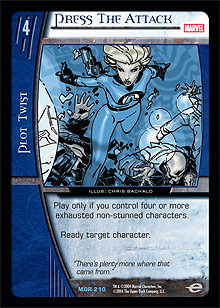 However, many players don’t get that draw or are not canny enough to see how it works. If you are trapped on evens, you’ll find a glimmer of hope if you escape the third turn without serious disadvantage. From there, you should play for numerical supremacy and for the better Roy and Terra. What this means is that Press the Attack becomes the most important card in the mirror. Once that third turn window elapses, Teen Titans Go! is no longer very important.
However, many players don’t get that draw or are not canny enough to see how it works. If you are trapped on evens, you’ll find a glimmer of hope if you escape the third turn without serious disadvantage. From there, you should play for numerical supremacy and for the better Roy and Terra. What this means is that Press the Attack becomes the most important card in the mirror. Once that third turn window elapses, Teen Titans Go! is no longer very important.
The most compelling feature of the Titans mirror is how much even the smallest advantage will lead to a win if not pulled back almost immediately. Unfortunately, there is very little you can do about that except to put your head down and make the right plays. Fortunately, if things aren’t going your way, you will quickly be aware of it and be put out of your misery in short order.
Versus TNB
Some of you might not think this archetype is relevant anymore, but I like to reference it for an important reason. TNB is still the gold standard when it comes to pure rush decks. The stats of its characters and the quality of their support are unlikely to be rivaled in Golden Age. At the moment, GLEE and Titans are both very good against it, and Sentinels (i.e. Nimrod) can hold its own. Understanding how to play a matchup where your opponent hits an aggressive attack curve from turn 1 is an important exercise. Fortunately, the Titans do this better than everyone else does.
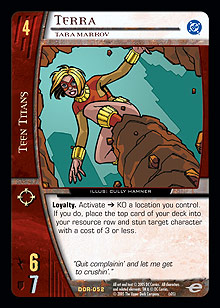 The key to this sort of matchup is always Terra first and Heroic Sacrifice second. Terra can be a ridiculously powerful card. Her ability not only stuns a character, but it also effectively plugs reinforcement channels by removing an attacker who is usually sent in to break them up, thus preventing endurance loss. Heroic Sacrifice is a strange card in that it is extremely powerful, but you will rarely want to play more than one in a match. The prevalence of range among the Titans’ higher drops often means that reinforcing is a good enough option, anyway. However, in matchups where players need to put all of their eggs in one basket by pumping a character with everything they have, you can’t go past Heroic Sacrifice—a Fast Getaway that stuns your smaller characters at the expense of the bigger, harder to recruit ones is always going to be amazing. In the end, you want to be conservative because your cards are just better than theirs are.
The key to this sort of matchup is always Terra first and Heroic Sacrifice second. Terra can be a ridiculously powerful card. Her ability not only stuns a character, but it also effectively plugs reinforcement channels by removing an attacker who is usually sent in to break them up, thus preventing endurance loss. Heroic Sacrifice is a strange card in that it is extremely powerful, but you will rarely want to play more than one in a match. The prevalence of range among the Titans’ higher drops often means that reinforcing is a good enough option, anyway. However, in matchups where players need to put all of their eggs in one basket by pumping a character with everything they have, you can’t go past Heroic Sacrifice—a Fast Getaway that stuns your smaller characters at the expense of the bigger, harder to recruit ones is always going to be amazing. In the end, you want to be conservative because your cards are just better than theirs are.
Versus GL/EE or Kiwi Fruit
The New Zealanders that first designed this deck knew one thing: the deck just plain falls down against Titans. Apart from being vulnerable to Flame Trap, the Green Lanterns don’t have any game against Garth and friends. The Titans player doesn’t even have to draw well.
Firstly, their long-game plan to put Sinestro into the hidden zone is negated by Roy Harper, and any recovery plans they might entertain are countered by Press the Attack and Teen Titans Go! Knowing that your late game can easily trump your opponent’s allows you to think of this matchup as an early to mid-game skirmish that the opponent has to win to have a chance. Fortunately, your characters are better. You want to angle for the default Titans board where you stun your opponent’s team and attack directly. This is surprisingly easy, as the opponent’s characters put up little resistance when defending. As long as you remember that the opponent’s only out is to keep Sinestro hidden and face-up, you’ll win easily.
Versus New School
This matchup is intriguing for a number of reasons, the biggest being that you are finally playing against a deck (and a matchup, for that matter) where your opponent makes more decisions than you do. Additionally, there are key elements to the matchup that require you to play a little differently than normal.
 You have two typical winning scenarios. Always in the front of your mind should be the plan to clear the opponent’s board with Teen Titans Go! Attack with two characters as a time—no more—and then ready them all when all minimally constructed team-attacks have been formed. This plan is made harder by the presence of Dr. Doom, Diabolic Genius, who prevents you from playing plot twists from your hand. Thus, your initial aim is to have a Teen Titans Go! in the row and stun Doom to ensure that you can play things from the hand after that. Additionally, the threats of Reign of Terror and Mystical Paralysis must always be respected.
You have two typical winning scenarios. Always in the front of your mind should be the plan to clear the opponent’s board with Teen Titans Go! Attack with two characters as a time—no more—and then ready them all when all minimally constructed team-attacks have been formed. This plan is made harder by the presence of Dr. Doom, Diabolic Genius, who prevents you from playing plot twists from your hand. Thus, your initial aim is to have a Teen Titans Go! in the row and stun Doom to ensure that you can play things from the hand after that. Additionally, the threats of Reign of Terror and Mystical Paralysis must always be respected.
What this means is that a number of smaller characters are nearly always better than a large one. You will want to recruit Garth, but I’m going to be controversial and argue that Terra is not as necessary in this matchup as she would seem to be. She is worth playing if you don’t lose too much by it, but I wouldn’t stress about it. Your opponent is going to get Compressor for Roy anyway, and more than anything else, you want characters that can team attack. There is no point is stunning Shimmer unless you can attack, too. Robot Sentry works hard for the opponent in this matchup, but remember that Hank/Dawn are only a bad investment when they can get two Sentries. That’s not impossible, but unless your opponent naturally drew one, I wouldn’t be too concerned.
The second winning scenario is to recur Foiled infinitely with Garth, and this plan should always be in the back of your mind. If you can get this online, your opponent will just lose, as the New School player needs team-ups. That said, a single Fizzle will leave your Foiled stranded in your row, so you need to make sure that your opponent doesn’t have it by baiting him or her with other effects first.
This matchup has a few other factors to consider. Your opponent is trying to get to Psimon, which will just shut you down. If this guy resolves, only Roy can get you out of it, and it’s likely that he’ll be eliminated with a Compressor on an earlier turn. What this means is that you’re looking for an initiative that isn’t your opponent’s Reign of Terror turn or Psimon turn on which to win the game. Don’t automatically put locations in the row—put the plot twists you have to play there first. Attack minimally and for board position; you don’t need to deal endurance loss until you attack directly. Flight is very important here. A good New School player will tap down Dawn before Hank. When your opponent’s board begins to crumble, the endurance will flow from him or her in buckets.
Versus A Child Named Valeria
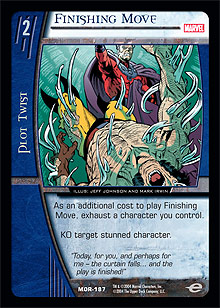 The Titans have a natural advantage against other weenie builds, namely because their characters are better overall and it has better control over combat. You want to force your opponent into combat to maximize these advantages. What gives combo weenie decks game against Titans is A Child Named Valeria. Fortunately, playing the full complement of Finishing Moves gives you an out. You want to set up a position where the opponent is forced to use Child and you respond by stunning either Invisible Woman or Mr. Fantastic with Roy or Terra. Then you want to use Finishing Move to KO the stunned character so that Child doesn’t come online properly when it resolves. This is not always easy, and there is no point doing it unless you can then go on to wreck the rest of your opponent’s board. However, it is really the most important strategic axis in these matchups and relatively easy to spot, as not many beatdown decks run Invisible Woman, Invisible Girl, or Mr. Fantastic, Reed Richards.
The Titans have a natural advantage against other weenie builds, namely because their characters are better overall and it has better control over combat. You want to force your opponent into combat to maximize these advantages. What gives combo weenie decks game against Titans is A Child Named Valeria. Fortunately, playing the full complement of Finishing Moves gives you an out. You want to set up a position where the opponent is forced to use Child and you respond by stunning either Invisible Woman or Mr. Fantastic with Roy or Terra. Then you want to use Finishing Move to KO the stunned character so that Child doesn’t come online properly when it resolves. This is not always easy, and there is no point doing it unless you can then go on to wreck the rest of your opponent’s board. However, it is really the most important strategic axis in these matchups and relatively easy to spot, as not many beatdown decks run Invisible Woman, Invisible Girl, or Mr. Fantastic, Reed Richards.
Versus Common Enemy
This deck just never seems to go away, although it often struggles with straight Curve decks like Sentinels. Its matchup with Titans is poorly understood. Common Enemy definitely has the tools to beat Titans, but the inverse is also true.
Similar to New School, Common Enemy’s MVP is the 4-drop Doom, but instead of Psimon, it works toward Thing, The Ever-Lovin’ Blue-Eyed Thing and then Silver Surfer for the lock. Unfortunately for them, you are much better equipped to deal with a single large characters than a series of smaller drops. Common Enemy beats you earlier than New School does, but you have Finishing Move and much more obvious attacks.
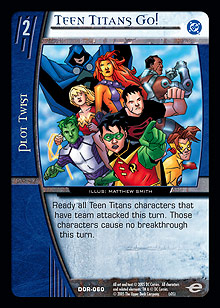 The lack of Fizzle for this plan hurts the Common Enemy player, as teaming up is a vital part of the deck, even though it only runs four copies of its team-up. Being able to replay a turn with Foiled can help you delay the TELBET turn that little bit longer, which is often enough to win. Remember that at its heart, Common Enemy is still a curve deck with glorified tricks, and while it’s one of the more interesting and creative decks around, it still suffers from many of the vulnerabilities of curve. Reign of Terror and Mystical Paralysis are again key, but if you can engineer a successful Teen Titans Go!, it will be very hard to lose. Typically, your opponent wants to Reign your low drops and then Paralyze Garth, leaving you with only one attacker on turn 5. Because of this and Thing, the even initiative is a better bet, but you really need to know that you’re playing Common Enemy before choosing evens. As above, Foiled is devastating to Common Enemy, and the Roy Harper/Press interaction operates practically unfettered on turn 6.
The lack of Fizzle for this plan hurts the Common Enemy player, as teaming up is a vital part of the deck, even though it only runs four copies of its team-up. Being able to replay a turn with Foiled can help you delay the TELBET turn that little bit longer, which is often enough to win. Remember that at its heart, Common Enemy is still a curve deck with glorified tricks, and while it’s one of the more interesting and creative decks around, it still suffers from many of the vulnerabilities of curve. Reign of Terror and Mystical Paralysis are again key, but if you can engineer a successful Teen Titans Go!, it will be very hard to lose. Typically, your opponent wants to Reign your low drops and then Paralyze Garth, leaving you with only one attacker on turn 5. Because of this and Thing, the even initiative is a better bet, but you really need to know that you’re playing Common Enemy before choosing evens. As above, Foiled is devastating to Common Enemy, and the Roy Harper/Press interaction operates practically unfettered on turn 6.
Hopefully I have made clear what I consider some of the more successful approaches to playing the various Teen Titans matchups. The Titans possess a rare combination of power and flexibility, but their lack of a powerful late game (their only real weakness) demands that you pick the right plan the first time. I am happy to answer any emails at muly233@hotmail.comail, particularly about the matchups I didn’t cover. Until then, always be the one thinking two turns ahead!